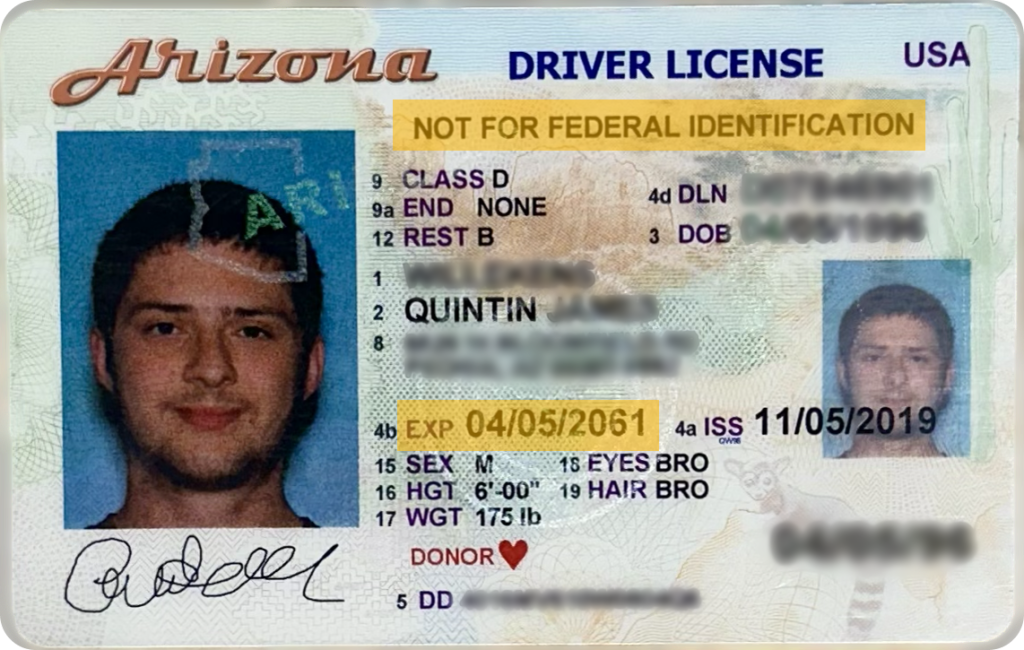The main difference between a REAL ID and a passport is that a REAL ID is any form of identification that meets the criteria of the REAL ID Act, while a passport is specifically a federal ID for traveling internationally. REAL IDs are most commonly driver’s licenses or state IDs, but a U.S. passport can be used in every situation in which a REAL ID is required.
Since May 7, 2025, the REAL ID Act enforcement began, and a compliant ID is now needed at any federal location, such as TSA checkpoints. This means that a non-REAL ID driver’s license is no longer accepted for any domestic flights in the U.S., and travelers will need a passport or other form of REAL ID.
In this guide, we break down REAL IDs vs Passports and explain the differences. When you need to get a passport quickly, check out our guide on how to get a passport in two weeks or less.
In This Guide: REAL ID vs Passport
![]()
What Is a REAL ID?
A REAL ID is a state-issued driver’s license or identification card that meets federal security standards established by the REAL ID Act. Since May 7, 2025, every air traveler aged 18 years or older needs a REAL ID-compliant license or another acceptable form of identification to fly within the United States.
Purpose and Use Cases
- Domestic Travel: Required for boarding domestic flights in the U.S.
- Federal Facilities: Necessary for entering federal buildings and nuclear power plants.
- Minors Exemption: REAL IDs are only needed for travelers 18 years and older; minors are exempt when traveling with an adult.
How to Apply for a REAL ID
To apply for a REAL ID you must visit your local Department of Motor Vehicles (DMV). Every state now offers REAL ID compliant driver’s licenses and state IDs. REAL IDs require additional documentation and often come with higher fees. Typically, you are given the choice on whether to get a REAL ID compliant ID or the standard ID.
Here is the process to apply for a REAL ID:
- Visit Your State DMV: REAL IDs are issued by state DMV offices (Use this tool to find your nearest DMV office).
- Provide Documentation: You’ll need proof of identity, your social security number, residency, and lawful status.
- Security Checks: The process includes additional security checks compared to a standard driver’s license.
The standard documents required to apply include:
- Proof of Identity: Birth certificate, Valid passport or Permanent resident card.
- Proof of Social Security Number: Social security card or tax document.
- Proof of Residency: Utility bill, lease agreement or mortgage statement.
- Proof of Lawful Status: Documentation of citizenship or legal presence in the U.S.
Why Do I Need a REAL ID?
From May 7, 2025, a REAL ID is required for:
- Boarding domestic flights within the U.S.
- Accessing federal facilities and nuclear power plants.
Without a REAL ID, your driver’s license or state ID will no longer be accepted by the federal government and you will need to present other federally accepted identification, like a passport.
How to Tell If My State ID or Driver’s License is REAL ID-Compliant?
Identifying a REAL ID Act-compliant ID is as easy as finding one of the following symbols in the top corner of the card:
![]()

Arizona has the longest period of validity for licenses in the country.
Many older licenses will make it even easier for you by printing: “NOT FOR FEDERAL IDENTIFICATION” on the front of the ID. Many states were slow to adopt the changes for the REAL ID system and some did not start offering compliant IDs until recent years.
On the off chance that you are from Arizona like me, you might not need to renew your license for another 40 years or more. In that case, you might never have known that you needed to change your license to fly anywhere in the U.S.
What is a U.S. Passport?
A U.S. passport is an official document issued by the U.S. Department of State that certifies the identity and nationality of the holder. It allows for international travel by air, land, and sea, and serves as a globally recognized form of identification.
Between 45% and 50% of Americans have a valid passport as of 2026.
Purpose and Use Cases
- International Travel: Required for all international flights.
- Visa Requirements: Necessary for countries that require visas for entry.
- Global Identification: Accepted worldwide for all forms of travel and identification.
How to Apply for a Passport
- Complete the DS-11 Form: This is the application form for a U.S. passport.
- Gather Documentation: Proof of citizenship, photo ID and passport photo.
- Submit in Person: At a passport acceptance facility or passport agency.
A first-time passport for an adult will cost $165 and takes 4-6 weeks for standard processing after you submit all of the necessary documents.
Comparing REAL IDs and Passports
Cost & Validity: REAL ID vs Passport Book vs Passport Card
| Feature | REAL ID | Passport Book | Passport Card |
|---|---|---|---|
| First-time Cost | $20-$60 (varies by state) | $165 | $65 |
| Renewal Cost | $20-$60 (varies by state) | $130 | $30 |
| Validity Period | 4-8 years (varies by state) | 10 years (5 years for minors) | 10 years (5 years for minors) |
Where to Use: REAL ID vs Passport Book vs Passport Card
| Feature | REAL ID | Passport | Passport Card |
|---|---|---|---|
| Domestic Flights | Yes | Yes | Yes |
| International Air Travel | No | Yes | No |
| Land and Sea Travel | No | Yes | Yes (Canada, Mexico, Caribbean, Bermuda) |
| Federal Facilities | Yes | Yes | Yes |
| Visa Pages | No | Yes | No |

